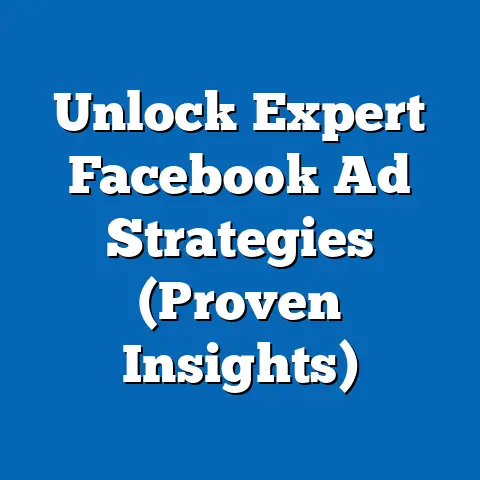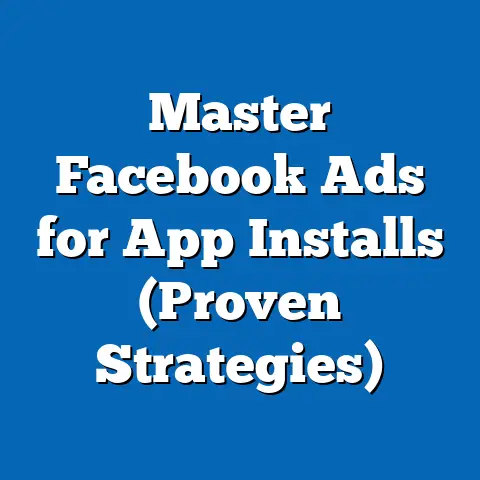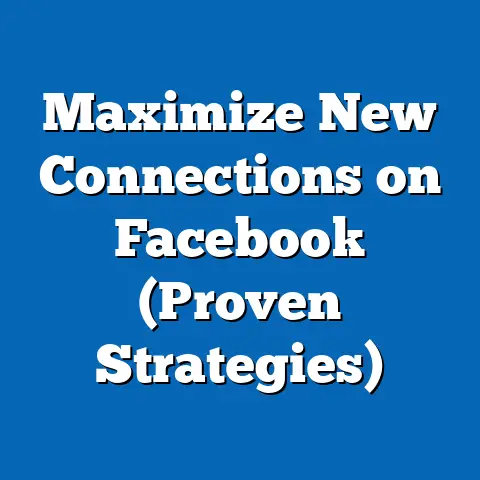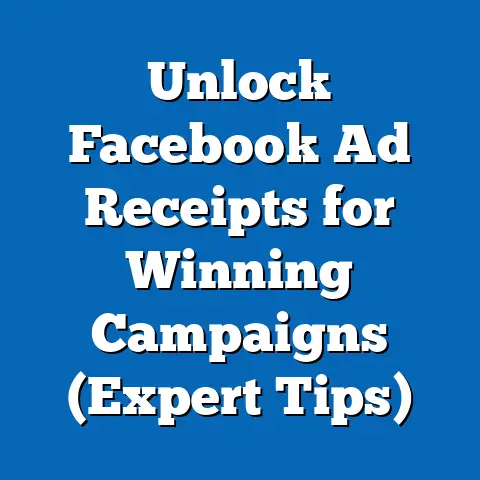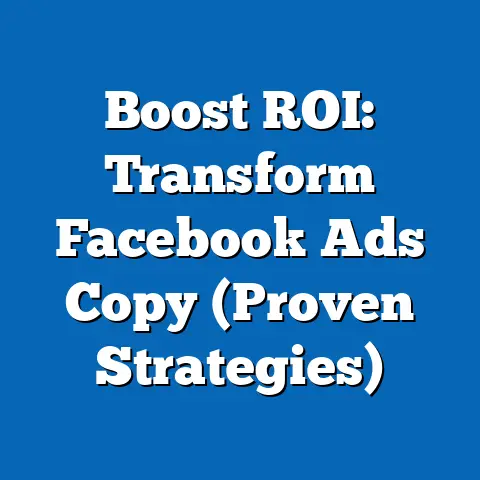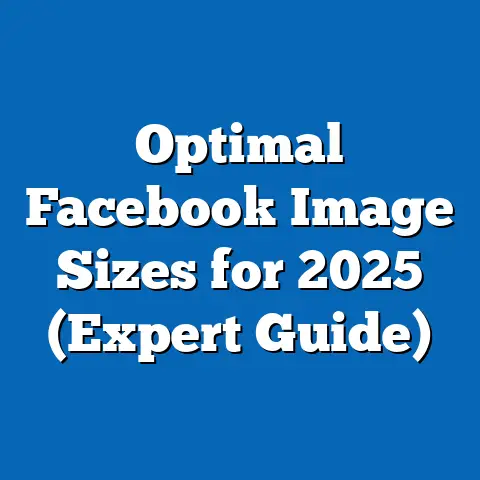Maximize ROI with ChatGPT for Facebook Ads (Pro Strategies)
In today’s digital landscape, where every click and impression counts, cost-effectiveness has become the holy grail of marketing. And nowhere is this truer than in the world of Facebook advertising. I’ve seen firsthand how easily budgets can balloon, leaving businesses scratching their heads, wondering where their ROI went. With ad costs steadily rising, it’s no longer enough to simply throw money at the problem. We need to be smarter, more strategic, and more efficient. That’s where ChatGPT comes in. This powerful AI tool offers a unique opportunity to optimize your Facebook ad campaigns, helping you squeeze every last drop of value from your advertising dollars. In this guide, I’ll share pro strategies for leveraging ChatGPT to achieve a significant increase in your ROI, turning those advertising woes into success stories.
Understanding ROI in Facebook Advertising
ROI, or Return on Investment, is the lifeblood of any successful advertising campaign. In the context of Facebook ads, it’s a measure of how much profit you generate for every dollar you spend. The higher your ROI, the better your campaign is performing. Calculating ROI involves a few key metrics, including:
- Conversion Rate: The percentage of people who click on your ad and complete a desired action, such as making a purchase or filling out a form.
- Cost Per Acquisition (CPA): The amount you spend to acquire a new customer through your Facebook ads.
- Lifetime Value (LTV): The total revenue you expect to generate from a single customer over the course of their relationship with your business.
ROI can be calculated using a simple formula: (Revenue – Cost) / Cost x 100. For example, if you spend $100 on Facebook ads and generate $300 in revenue, your ROI would be ($300 – $100) / $100 x 100 = 200%.
However, achieving a positive ROI isn’t always easy. I’ve witnessed countless campaigns stumble due to common pitfalls like:
- Poor Targeting: Reaching the wrong audience with your ads can lead to low engagement and wasted ad spend.
- Uncompelling Ad Copy: If your ad copy doesn’t grab attention and resonate with your target audience, they’re unlikely to click.
- Lack of A/B Testing: Failing to test different ad variations can leave you stuck with underperforming ads.
- Ignoring Engagement: Not responding to comments and messages can create a negative brand image and hurt your ROI.
That’s where AI, and particularly ChatGPT, comes in as a strategic ally. It can help you overcome these challenges by analyzing data, generating creative content, and optimizing your campaigns for maximum impact. It’s like having a dedicated marketing assistant, available 24/7 to help you achieve your advertising goals. This is something I have personally experienced and seen the benefits of, especially when dealing with large amounts of data that would have taken hours to process manually.
Key Takeaway: ROI is the ultimate measure of success in Facebook advertising. Understanding the key metrics and common pitfalls is the first step towards maximizing your return on investment.
Crafting Compelling Ad Copy with ChatGPT
Ad copy is the first impression you make on potential customers. It’s what grabs their attention, sparks their interest, and motivates them to click on your ad. In my experience, effective ad copy can significantly influence click-through rates (CTR) and conversion rates, ultimately driving up your ROI.
ChatGPT can be a game-changer when it comes to crafting compelling ad copy. Here’s a step-by-step guide on how to utilize it:
-
Define Your Target Audience: Start by providing ChatGPT with detailed information about your target audience, including their demographics, interests, pain points, and motivations. The more specific you are, the better the results will be. For example, instead of saying “young adults interested in fitness,” try “25-35 year old women living in urban areas who are interested in yoga, healthy eating, and sustainable living.”
-
Specify Your Ad Goal: Clearly state the goal of your ad campaign, whether it’s to drive website traffic, generate leads, or increase sales. This will help ChatGPT tailor the ad copy to achieve the desired outcome.
-
Provide Keywords and Key Messaging: Include relevant keywords and key messaging points that you want ChatGPT to incorporate into the ad copy. This will ensure that the generated content aligns with your brand and resonates with your target audience.
-
Generate Ad Copy Options: Ask ChatGPT to generate multiple ad copy options, each with a different angle or approach. This will give you a variety of options to choose from and test. For example, you could ask for one ad copy option that focuses on the benefits of your product, another that highlights its unique features, and a third that addresses a specific pain point.
-
Refine and Iterate: Once you have a few ad copy options, review them carefully and refine them to align with your brand voice and messaging. You can also use ChatGPT to generate variations of the existing ad copy, experimenting with different headlines, calls to action, and sentence structures.
Define Your Target Audience: Start by providing ChatGPT with detailed information about your target audience, including their demographics, interests, pain points, and motivations. The more specific you are, the better the results will be. For example, instead of saying “young adults interested in fitness,” try “25-35 year old women living in urban areas who are interested in yoga, healthy eating, and sustainable living.”
Specify Your Ad Goal: Clearly state the goal of your ad campaign, whether it’s to drive website traffic, generate leads, or increase sales. This will help ChatGPT tailor the ad copy to achieve the desired outcome.
Provide Keywords and Key Messaging: Include relevant keywords and key messaging points that you want ChatGPT to incorporate into the ad copy. This will ensure that the generated content aligns with your brand and resonates with your target audience.
Generate Ad Copy Options: Ask ChatGPT to generate multiple ad copy options, each with a different angle or approach. This will give you a variety of options to choose from and test. For example, you could ask for one ad copy option that focuses on the benefits of your product, another that highlights its unique features, and a third that addresses a specific pain point.
Refine and Iterate: Once you have a few ad copy options, review them carefully and refine them to align with your brand voice and messaging. You can also use ChatGPT to generate variations of the existing ad copy, experimenting with different headlines, calls to action, and sentence structures.
Here’s a practical example:
Scenario: You’re advertising a new line of organic skincare products targeting millennial women.
Prompt for ChatGPT: “Write three different Facebook ad copy options for organic skincare products targeting millennial women aged 25-35 who are interested in sustainable beauty and natural ingredients. Highlight the benefits of our products, such as reducing inflammation, hydrating skin, and preventing premature aging. Include a call to action to visit our website and learn more.”
Example ChatGPT Output:
-
Option 1: “Tired of harsh chemicals in your skincare routine? ✨ Discover our new line of organic skincare products, formulated with natural ingredients to reduce inflammation, hydrate your skin, and prevent premature aging. 🌱 Shop now and experience the difference! [Link]”
-
Option 2: “Millennial women, are you ready to glow? ✨ Our organic skincare products are designed to nourish your skin from the inside out, using only the purest, most sustainable ingredients. 🌿 Say goodbye to dryness, redness, and wrinkles! ➡️ Learn more at [Link]”
-
Option 3: “Invest in your skin, invest in the planet. 🌎 Our organic skincare products are not only good for your skin, but they’re also good for the environment. ♻️ Made with ethically sourced ingredients and packaged in eco-friendly materials, our products are the perfect choice for conscious consumers. 🛍️ Shop now and support sustainable beauty! [Link]”
Option 1: “Tired of harsh chemicals in your skincare routine? ✨ Discover our new line of organic skincare products, formulated with natural ingredients to reduce inflammation, hydrate your skin, and prevent premature aging. 🌱 Shop now and experience the difference! [Link]”
Option 2: “Millennial women, are you ready to glow? ✨ Our organic skincare products are designed to nourish your skin from the inside out, using only the purest, most sustainable ingredients. 🌿 Say goodbye to dryness, redness, and wrinkles! ➡️ Learn more at [Link]”
Option 3: “Invest in your skin, invest in the planet. 🌎 Our organic skincare products are not only good for your skin, but they’re also good for the environment. ♻️ Made with ethically sourced ingredients and packaged in eco-friendly materials, our products are the perfect choice for conscious consumers. 🛍️ Shop now and support sustainable beauty! [Link]”
Key Takeaway: ChatGPT can be a powerful tool for generating creative and compelling ad copy. By providing it with detailed information about your target audience and ad goals, you can leverage its capabilities to create ads that grab attention, resonate with your audience, and drive results.
Target Audience Analysis and Segmentation
Understanding your target audience is paramount to successful ad campaigns. It’s not enough to simply know their age and gender; you need to delve deeper into their demographics, interests, behaviors, and motivations. I’ve found that the more you know about your audience, the better you can tailor your ads to resonate with them, leading to higher engagement and improved ROI.
ChatGPT can assist in analyzing audience data and generating insights on potential customer segments. Here’s how:
-
Gather Audience Data: Collect data from various sources, including Facebook Insights, Google Analytics, customer surveys, and CRM systems. This data should include information about your audience’s demographics, interests, online behavior, and purchasing habits.
-
Input Data into ChatGPT: Provide ChatGPT with the collected data and ask it to analyze the information and identify potential customer segments. You can ask it to look for common traits, patterns, and trends that can help you group your audience into distinct segments.
-
Generate Audience Personas: Based on the identified segments, ask ChatGPT to generate detailed audience personas for each segment. These personas should include information about the segment’s demographics, interests, motivations, pain points, and online behavior.
-
Create Personalized Ad Campaigns: Once you have your audience personas, you can use them to create personalized ad campaigns that are tailored to the specific needs and interests of each segment. This can involve creating different ad copy, imagery, and targeting options for each segment.
Gather Audience Data: Collect data from various sources, including Facebook Insights, Google Analytics, customer surveys, and CRM systems. This data should include information about your audience’s demographics, interests, online behavior, and purchasing habits.
Input Data into ChatGPT: Provide ChatGPT with the collected data and ask it to analyze the information and identify potential customer segments. You can ask it to look for common traits, patterns, and trends that can help you group your audience into distinct segments.
Generate Audience Personas: Based on the identified segments, ask ChatGPT to generate detailed audience personas for each segment. These personas should include information about the segment’s demographics, interests, motivations, pain points, and online behavior.
Create Personalized Ad Campaigns: Once you have your audience personas, you can use them to create personalized ad campaigns that are tailored to the specific needs and interests of each segment. This can involve creating different ad copy, imagery, and targeting options for each segment.
For example, let’s say you’re selling online courses. After analyzing your audience data with ChatGPT, you identify three distinct segments:
- Segment 1: Career Changers: Individuals in their late 20s and early 30s who are looking to switch careers and acquire new skills.
- Segment 2: Lifelong Learners: Individuals in their 40s and 50s who are passionate about learning new things and expanding their knowledge.
- Segment 3: Skill Enhancers: Individuals in their early 20s who are looking to enhance their existing skills and gain a competitive edge in the job market.
Using this information, you can create personalized ad campaigns for each segment, highlighting the benefits of your courses that are most relevant to their specific needs and interests. For example, for the “Career Changers” segment, you could focus on how your courses can help them land a new job and increase their earning potential. For the “Lifelong Learners” segment, you could focus on the intellectual stimulation and personal fulfillment that comes with learning new things. And for the “Skill Enhancers” segment, you could focus on how your courses can help them improve their resumes and stand out from the crowd.
Key Takeaway: Understanding your target audience is crucial for creating effective ad campaigns. ChatGPT can help you analyze audience data, identify potential customer segments, and create personalized ad campaigns that resonate with each segment, leading to higher engagement and improved ROI.
Ad Testing and Optimization Strategies
A/B testing, also known as split testing, is a cornerstone of successful Facebook advertising. It involves creating multiple versions of your ad and testing them against each other to see which performs best. I have personally found A/B testing to be invaluable in identifying winning ad variations that drive higher engagement and conversions.
ChatGPT can be a valuable tool for brainstorming different ad variations for testing. Here’s how:
-
Identify Key Variables: Determine which elements of your ad you want to test, such as headlines, ad copy, imagery, call-to-action buttons, and targeting options.
-
Generate Variations with ChatGPT: Use ChatGPT to generate different variations for each of the key variables you’ve identified. For example, you could ask it to generate three different headlines for your ad, each with a different angle or approach.
-
Set Up A/B Tests in Facebook Ads Manager: Use Facebook Ads Manager to create A/B tests for each of the key variables you’re testing. This will allow you to compare the performance of different ad variations and identify the winners.
-
Analyze Performance and Iterate: Monitor the performance of your A/B tests closely and analyze the data to identify which ad variations are performing best. Based on the results, iterate on your ads and create new variations to test.
Identify Key Variables: Determine which elements of your ad you want to test, such as headlines, ad copy, imagery, call-to-action buttons, and targeting options.
Generate Variations with ChatGPT: Use ChatGPT to generate different variations for each of the key variables you’ve identified. For example, you could ask it to generate three different headlines for your ad, each with a different angle or approach.
Set Up A/B Tests in Facebook Ads Manager: Use Facebook Ads Manager to create A/B tests for each of the key variables you’re testing. This will allow you to compare the performance of different ad variations and identify the winners.
Analyze Performance and Iterate: Monitor the performance of your A/B tests closely and analyze the data to identify which ad variations are performing best. Based on the results, iterate on your ads and create new variations to test.
For example, let’s say you’re running an ad campaign to promote a new e-book. You decide to test two different headlines:
- Headline A: “Download Your Free E-Book Today!”
- Headline B: “Learn the Secrets to Success with Our New E-Book”
After running the A/B test for a week, you find that Headline B has a significantly higher click-through rate than Headline A. Based on this data, you decide to use Headline B in your ad campaign.
In addition to testing headlines, you can also use ChatGPT to brainstorm different imagery options, ad copy variations, and call-to-action buttons. The key is to continuously test and optimize your ads based on data-driven insights. I’ve seen many advertisers fail because they set up their ads and never touch them again. Constant monitoring and iteration is essential for maximizing ROI.
Key Takeaway: A/B testing is crucial for maximizing ROI in Facebook advertising. ChatGPT can help you brainstorm different ad variations for testing, allowing you to identify the winning ads that drive higher engagement and conversions.
Leveraging ChatGPT for Audience Engagement
Engagement is a critical factor in boosting ad effectiveness and ROI. When people interact with your ads, it signals to Facebook that your content is valuable and relevant, which can lead to higher ad rankings and lower costs. I’ve learned that fostering engagement also builds trust and strengthens your relationship with potential customers.
ChatGPT can be used to craft engaging responses for comments and messages related to your Facebook ads. Here’s how:
-
Monitor Comments and Messages: Keep a close eye on the comments and messages you receive on your Facebook ads. This will allow you to identify opportunities to engage with your audience and address any questions or concerns they may have.
-
Use ChatGPT to Generate Responses: When responding to comments and messages, use ChatGPT to generate personalized and engaging responses. Provide it with the context of the comment or message and ask it to craft a response that is helpful, informative, and aligned with your brand voice.
-
Personalize Your Responses: While ChatGPT can generate great responses, it’s important to personalize them to make them feel more authentic and genuine. Add a personal touch, such as addressing the person by name or referencing something specific they mentioned in their comment or message.
-
Encourage Further Engagement: End your responses with a call to action that encourages further engagement, such as asking a question, inviting them to visit your website, or offering a discount code.
Monitor Comments and Messages: Keep a close eye on the comments and messages you receive on your Facebook ads. This will allow you to identify opportunities to engage with your audience and address any questions or concerns they may have.
Use ChatGPT to Generate Responses: When responding to comments and messages, use ChatGPT to generate personalized and engaging responses. Provide it with the context of the comment or message and ask it to craft a response that is helpful, informative, and aligned with your brand voice.
Personalize Your Responses: While ChatGPT can generate great responses, it’s important to personalize them to make them feel more authentic and genuine. Add a personal touch, such as addressing the person by name or referencing something specific they mentioned in their comment or message.
Encourage Further Engagement: End your responses with a call to action that encourages further engagement, such as asking a question, inviting them to visit your website, or offering a discount code.
For example, let’s say someone comments on your ad asking about the ingredients in your skincare products. You could use ChatGPT to generate the following response:
“Hi [Name], thanks for your question! Our skincare products are made with all-natural, organic ingredients, including aloe vera, jojoba oil, and shea butter. You can find a full list of ingredients on our website: [Link]. Do you have any other questions about our products?”
By providing a helpful and informative response, you’re not only addressing the person’s question but also demonstrating your commitment to customer satisfaction and building trust. This can lead to higher customer loyalty and better ad performance.
Key Takeaway: Engaging with your audience is crucial for boosting ad effectiveness and ROI. ChatGPT can help you craft engaging responses for comments and messages, allowing you to build trust, foster relationships, and improve your ad performance.
Conclusion
In conclusion, ChatGPT offers a powerful suite of tools to enhance your Facebook advertising ROI. By leveraging its capabilities to craft compelling ad copy, analyze target audiences, optimize campaigns through A/B testing, and engage with your audience, you can achieve significant cost-effectiveness in your advertising efforts. I have personally seen these strategies work, transforming struggling campaigns into profit-generating machines.
I encourage you to implement these pro strategies in your Facebook ad campaigns to unlock their full potential. Embrace the power of AI tools like ChatGPT to stay ahead of the curve and achieve a significant increase in your ROI. The world of digital marketing is constantly evolving, and embracing innovation is the key to long-term success.
Ready to take your Facebook advertising to the next level? Explore the potential of AI tools like ChatGPT and witness the transformation in your campaign performance. Start today and unlock the true potential of your advertising efforts!

